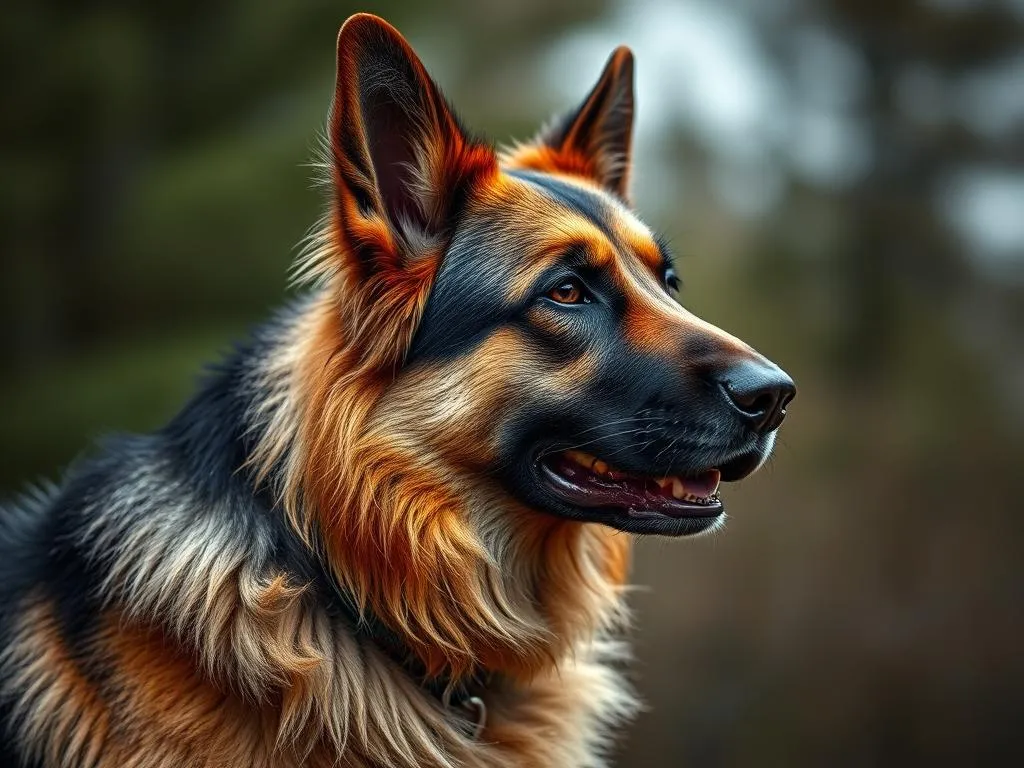
Dogs have been companions to humans for thousands of years, evolving from wild animals into the diverse breeds we see today. Each breed comes with its own set of characteristics, temperament, and care requirements, making it essential for potential owners to understand these aspects before bringing a dog into their home. Among the various breeds, the Old German Shepherd stands out for its unique traits and historical significance, offering potential owners a glimpse into an extraordinary lineage of canines.
Understanding Dog Breeds
Definition of Dog Breeds
A dog breed is a specific group of domestic dogs that share similar physical characteristics, behaviors, and genetic traits. Breeds have been developed through selective breeding practices that aim to enhance desirable traits while minimizing unwanted ones. Understanding breed characteristics is crucial for prospective dog owners, as these traits dictate how a dog behaves, interacts, and thrives in different environments.
The Role of Breeding in Dog Characteristics
Selective breeding has played a pivotal role in the development of dog breeds. Originally, dogs were bred for specific functions, such as herding, hunting, or guarding. This practice has shaped not only the physical appearance of the breeds but also their temperament and health. For example, working breeds like the German Shepherd have been bred for intelligence and loyalty, making them excellent companions and service animals. Understanding the implications of breeding can help potential owners choose a breed that fits their lifestyle and expectations.
Importance of Choosing the Right Breed
When selecting a dog, various factors should be considered, including lifestyle, living space, and the dog’s energy level. The right breed can enhance your life and create a harmonious living environment. Conversely, choosing a breed that doesn’t match your lifestyle can lead to frustration for both the owner and the dog. It’s essential to understand how different breeds, like the Old German Shepherd, require varying levels of training, socialization, and care.
Overview of the German Shepherd Breed
History of the German Shepherd
The German Shepherd breed originated in Germany in the late 19th century. It was developed by Captain Max von Stephanitz, who aimed to create a versatile herding dog. The first official German Shepherd was registered in 1899, and the breed quickly gained popularity for its intelligence and working ability. Over the years, the breed has been utilized in various roles, including police, military, and search and rescue operations, solidifying its reputation as one of the most capable dog breeds.
Characteristics of the German Shepherd
German Shepherds are large, powerful dogs with a well-balanced physique. They typically weigh between 50 to 90 pounds and stand 22 to 26 inches tall at the shoulder. Their coats are usually medium-length and can be black and tan, sable, or all black.
In terms of temperament, German Shepherds are known for their intelligence, loyalty, and protective instincts. They form strong bonds with their families and are often wary of strangers, making them excellent watchdogs. The average lifespan of a German Shepherd is around 9 to 13 years, but they can be prone to certain health issues, including hip dysplasia and degenerative myelopathy.
The Old German Shepherd: A Closer Look
Defining the Old German Shepherd
The Old German Shepherd is a variant of the German Shepherd that retains the traditional characteristics of the breed. Unlike the modern German Shepherd, which has been bred for specific traits that prioritize appearance over function, the Old German Shepherd emphasizes a more natural structure and temperament. These dogs are known for their stability and well-rounded nature, making them ideal companions for families and working environments.
Historical Context
The evolution of the Old German Shepherd can be traced back to the breed’s origins. As dog shows and breed clubs began to gain popularity in the early 20th century, the focus shifted towards specific physical traits, leading to changes in the breed’s appearance. The Old German Shepherd was developed to bring back the traditional traits that were gradually being lost, emphasizing a balanced structure, a calmer temperament, and a focus on working ability.
Physical Characteristics
The Old German Shepherd typically exhibits a more natural, straight-backed physique compared to its modern counterpart. Adult males generally weigh between 75 to 95 pounds, while females range from 50 to 75 pounds. Their coats can vary in color but are often a combination of black and tan or sable.
Distinct features of the Old German Shepherd include a broader head, deep chest, and a thicker neck. These attributes contribute to a more powerful and athletic appearance, making them well-suited for various tasks.
Temperament and Behavior
The temperament of the Old German Shepherd is characterized by its calm and stable nature. Unlike some modern German Shepherds, which may exhibit anxiety or hyperactivity, the Old German Shepherd is generally more laid-back and easygoing. They are intelligent and eager to please, making them highly trainable. Their loyalty and protective instincts make them excellent family dogs and watchdogs, providing a sense of security to their owners.
Health and Care for the Old German Shepherd
Common Health Issues
Like all breeds, the Old German Shepherd is susceptible to certain health issues. Common concerns include:
- Hip Dysplasia: A genetic condition where the hip joint doesn’t fit properly into the hip socket, leading to arthritis and pain.
- Elbow Dysplasia: Similar to hip dysplasia but affects the elbow joint.
- Degenerative Myelopathy: A progressive disease of the spinal cord that leads to paralysis.
- Bloat: A serious condition where the stomach fills with gas, which can be life-threatening.
Preventative care measures, such as regular veterinary check-ups, proper nutrition, and controlled exercise, can help mitigate these risks.
Nutrition and Diet
Providing the right nutrition is essential for the overall health of your Old German Shepherd. A balanced diet rich in high-quality proteins, carbohydrates, and fats is crucial. Look for dog foods that list meat as the primary ingredient and avoid fillers like corn and soy. It’s also important to control portion sizes to prevent obesity, which can exacerbate health issues.
Exercise Needs
Old German Shepherds are active dogs that require regular exercise to maintain their physical and mental health. Daily walks, play sessions, and interactive games are essential for their well-being. Aim for at least 60 minutes of exercise each day, incorporating activities that challenge them mentally, like obedience training or agility courses.
Grooming Requirements
The grooming needs of the Old German Shepherd are relatively moderate. Their double coat requires brushing at least once a week to remove loose hair and prevent matting. During shedding seasons, more frequent brushing may be necessary. Regular baths, nail trimming, and dental care are also important aspects of their grooming routine.
Training and Socialization
Importance of Early Training
Starting training early is crucial for the Old German Shepherd. Early socialization helps them develop into well-rounded adults, reducing the likelihood of behavioral issues. Positive reinforcement techniques, such as treats and praise, are highly effective in training these intelligent dogs. Basic obedience training should cover commands like sit, stay, come, and heel.
Socialization Techniques
Socializing your Old German Shepherd with various people, environments, and other animals is vital for their development. Consider enrolling in puppy classes or arranged playdates with other dogs. Exposing them to different situations will help build their confidence and adaptability.
Advanced Training Options
For owners interested in advanced training, Old German Shepherds excel in various activities, including tracking, protection work, and agility training. Organizations and trainers specializing in these areas can provide resources and guidance to enhance your dog’s skills.
Living with an Old German Shepherd
Ideal Living Conditions
Old German Shepherds thrive in environments where they have space to move and play. A home with a large yard is ideal, but they can adapt to apartment living if provided sufficient exercise. They do well in various climates, though care should be taken in extreme temperatures. This breed is known for its compatibility with families, children, and even other pets, making them a versatile choice for many households.
Understanding Behavioral Issues
Like any breed, the Old German Shepherd can exhibit behavioral problems if not properly trained or socialized. Common issues include barking, chewing, and separation anxiety. Understanding the root causes of these behaviors is crucial for effective management. Consistent training, mental stimulation, and sufficient exercise can help mitigate these problems.
Building a Bond
Strengthening the owner-dog bond is essential for a happy relationship. Engaging in activities like training, playing fetch, and spending quality time together fosters companionship. The more time you invest in your Old German Shepherd, the more responsive and loyal they will become.
Conclusion
Understanding the Old German Shepherd is vital for anyone considering this breed. With a rich history, distinct characteristics, and unique temperament, they offer a rewarding experience for committed owners. Choosing the right breed involves careful consideration of lifestyle and needs, ensuring a harmonious relationship between you and your canine companion. Responsible pet ownership requires dedication, understanding, and love, making the journey with an Old German Shepherd a fulfilling one.









